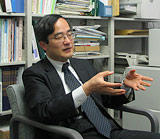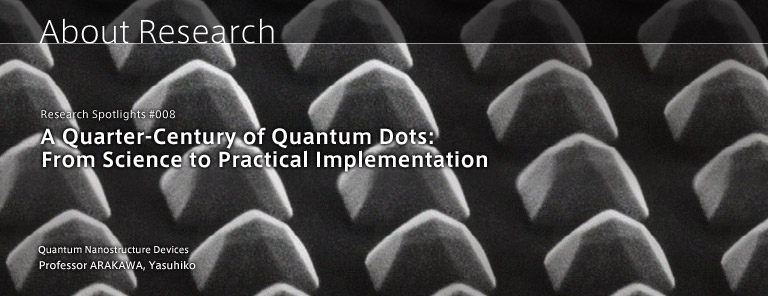With the establishment of a "quantum dot laser" company in April 2006, technology using principles that Professor Yasuhiko Arakawa and his colleagues proposed in 1982 was finally put to practical use. Arakawa had the option of joining the company, but as he said, "Being a scholar just agrees with me."
Confining Electrons within 10 Nanometers
One might conceive of "quantum dots" as something like air bubbles inside ice: large numbers of small dots made up of a substance that confines the motion of electrons are bundled inside another substance. Electrons that once moved freely are confined within each of the dots.
Professor Arakawa compares electrons to children running around on a playground. "We govern the movement of each 'child' by putting pits in the 'playground,' which is a two-dimensional plane," he explained. In this way, a zero-dimensional space is created in which the electron can not move left, right, up, or down.
As a result, it is possible to align electrons that have the same energy levels and efficiently generate a laser that has a wavelength with the same color. This type of laser is called a "quantum dot laser." Governing the movement of electrons makes it possible to govern photons as well.
The actual diameter of the "holes" in Arakawa's analogy is approximately 10 nanometers ("nano" means 10-9). In such small spaces, it is now possible to count the number of atoms, which is "approximately thirty."
With these advances, Arakawa says that it is becoming possible to see "the limits of the atom" within the tiny nano-world, just as "the limited nature of a planet that we once believed to be infinite" was recognized as an environmental problem. How to overcome these limits is a major issue for future technological innovation.
Science Aspiring to Create ?Artificial Nature?
Within an atom, electrons revolve around the nucleus. With quantum dots, electrons are confined within a 10-nm space, which might be called a massive "artificial atom." In this way, technology is used to create substances that did not previously exist in the natural world. Researching that process expands the object of scientific inquiry even further.
Professor Arakawa, who says that "science and technology have to work hand in hand," always had an interest in physics and mathematics, but he says that he entered an engineering department because "I wanted to be connected with society." Nevertheless, he thought that if he chose to work in the field of electronics, he could still grapple with physics if he changed his mind. In fact, both Yoshio Nishina and Paul Dirac started in electronics.
Looking for the Next Step while Keeping an Eye on Everything Else

-
Even now, when practical applications for quantum dot lasers are appearing before his eyes, Arakawa continues to stay involved with scientific research. "Working at a university," he explains, "there are times when I'm reminded of the simple yet essential perspective of the twenty-two-year-old students who come into the graduate school. That's what I find interesting about the university: I can stay involved with everything, from the students' simple viewpoints all the way to applied research."
As for the future, Arakawa says, "I'm thinking about the next step I want to take as a researcher."
Interviewer:Tomohisa Sumita
(March 31, 2006)


